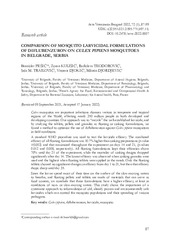Приказ основних података о документу
Comparison of mosquito larvicidal formulations of diflubenzuron on Culex pipiens mosquitoes in Belgrade, Serbia
Poređenje formulacija larvicida na bazi diflubenzurona na komarcima culex pipiens u beogradu, srbija
| dc.creator | Pešić, Branislav | |
| dc.creator | Kulišić, Zoran | |
| dc.creator | Teodorović, Radislava | |
| dc.creator | Trailović, Saša M. | |
| dc.creator | Djokić, Vitomir | |
| dc.creator | Djordjevic, Milutin | |
| dc.date.accessioned | 2022-05-23T09:04:04Z | |
| dc.date.available | 2022-05-23T09:04:04Z | |
| dc.date.issued | 2022 | |
| dc.identifier.issn | 0567-8315 | |
| dc.identifier.uri | https://vet-erinar.vet.bg.ac.rs/handle/123456789/2459 | |
| dc.description.abstract | Culex mosquitos are important infectious diseases vectors in temperate and tropical regions of the World, affecting nearly 350 million people in both developed and developing countries. Our approach was to “recycle” the well-established larvicide, and by studying the tablets, pellets and granules as floating or sinking formulations, we found a method to optimise the use of diflubenzuron against Culex pipiens mosquitoes in field conditions.A standard WHO procedure was used to test the larvicide efficacy. The combined efficacy of all floating formulations was 10.7% higher than sinking preparations (p-value =0.002) and that maximised throughout the experiment on days 14 and 21, (p-values 0.012 and 0.008, respectively). All floating formulations kept their efficacies above 70% until day 21 of the experiment, while the mortality of sinking designs dropped significantly after day 14. The lowest efficacy was observed when sinking granules were used and the highest when floating tablets were applied in the canals. Only the floating tablets showed no significant changes in efficacy from day 1 to 21, but then that efficacy drops sharp until day 35.Since the larvae spend most of their time on the surface of the slow-moving waters to breathe, and floating pellets and tablets are made of materials that can serve as food sources, we conclude that these formulations have a higher effi cacy, at least in conditions of non- or slow-moving waters. This study shows the importance of a systematic approach to reformulation of old, already proven and environmentally safe larvicides which can control the mosquito populations and their spreading of various pathogens. | |
| dc.language | en | |
| dc.publisher | Faculty of Veterinary Medicine, University of Belgrade | |
| dc.rights | openAccess | |
| dc.rights.uri | https://creativecommons.org/licenses/by/4.0/ | |
| dc.source | Acta Veterinaria | |
| dc.subject | Culex pipiens | |
| dc.subject | difl ubenzuron | |
| dc.subject | larvicide | |
| dc.subject | mosquito | |
| dc.title | Comparison of mosquito larvicidal formulations of diflubenzuron on Culex pipiens mosquitoes in Belgrade, Serbia | |
| dc.title | Poređenje formulacija larvicida na bazi diflubenzurona na komarcima culex pipiens u beogradu, srbija | |
| dc.type | article | en |
| dc.rights.license | BY | |
| dc.citation.volume | 72 | |
| dc.citation.issue | 1 | |
| dc.citation.spage | 87 | |
| dc.citation.epage | 99 | |
| dc.identifier.wos | 000778291600007 | |
| dc.identifier.doi | 10.2478/acve-2022-0007 | |
| dc.identifier.scopus | 2-s2.0-85128639535 | |
| dc.identifier.fulltext | http://veterinar.vet.bg.ac.rs/bitstream/id/6905/cf38312d9f525a511f45e2fe93b30b989e237454_07-Pesic.pdf | |
| dc.type.version | publishedVersion |

